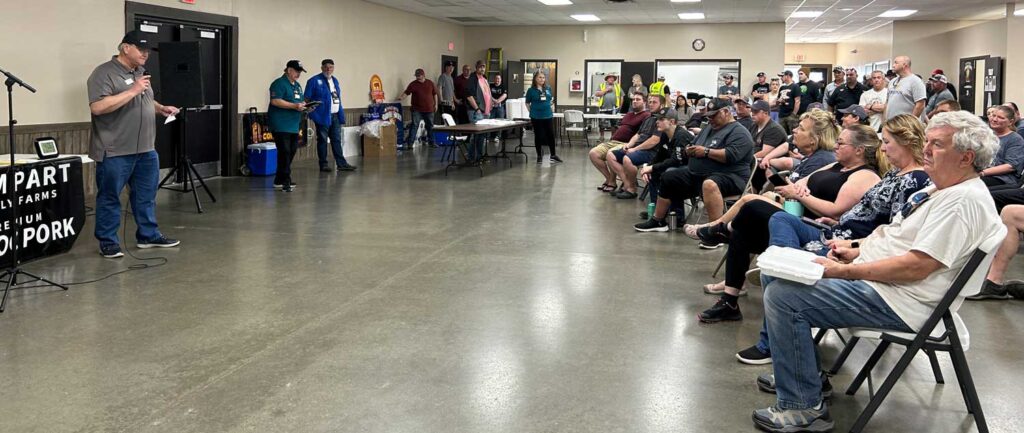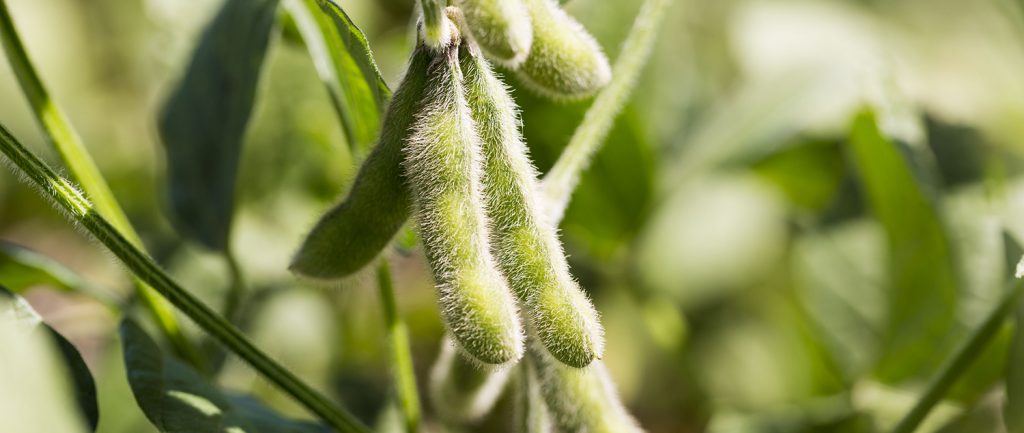The Minnesota Soybean Research & Promotion Council (MSR&PC) might not be able to solve all the world’s problems with soybeans, but checkoff investments can help to improve cardiovascular health – and it doesn’t even involve running.
By investing Minnesota soybean farmers’ checkoff resources, MSR&PC has played a critical role in the creation of TruSoya, a heart healthy soybean variety. Falling under Missouri Soybean Merchandising Council’s SOYLEIC variety, TruSoya’s Non-GMO High Oleic soybeans are the brainchild of Jim Orf, a renowned University of Minnesota breeder. With MSR&PC’s guidance, TruSoya has taken flight and is gaining national attention.
In August, industry leaders gathered to observe a TruSoya field. Planted by Minnesota soybean farmer and MSR&PC Vice Chair Tom Frisch, the 160-acre field may look like any other soybean field, but it is the culmination of five years of hard work to get TruSoya to commercialization.
“The beans look phenomenal,” said Frisch, who farms near Dumont. “There was a need for someone to grow TruSoya and it worked for me to fill the gap. I believe that if we all do our part, we can help advance agriculture.”
After the field tour, the group gathered at Brushvale Seed, Inc. to listen to speakers from industry partners, including the National Institute of Health (NIH), Northern Crops Institute (NCI), Brushvale Seed and MSR&PC.

“TruSoya is a new concept,” MSR&PC CEO Tom Slunecka said. “By adapting plant breeding to create this new value-added variety, the soybean industry is really starting to look forward instead of back. We’re creating a high-value marketplace, not a high-volume marketplace.”
Heart healthy
According to a recently completed study in which a “humanized” strain of laboratory mice were fed three different soybean-oil-containing diets for 12 weeks by researchers from NIH, TruSoya has the potential to reduce cardiovascular disease because of its Omega 6 and Omega 3 fatty acid balance. The ideal ratio of omega-6 to omega-3 is one to one and TruSoya retains the same level of omega-3s as commodity soybean oil.
“One hundred years ago, cardiovascular disease was quite rare,” said Alan Remaley, NIH’s Head of Lipoprotein Metabolism Section, Translational Vascular Medicine Branch (NHLBI). “Today, 7% of our diet comes from soybeans. If we have a healthier soy oil, I think it could have a huge public health impact.”
The one-to-one ratio of omega-6 to omega-3 allows the human body to convert adequate amounts of the TruSoya omega-3 (linolenic acid) into the cardiovascular-beneficial eicosapentaenoic acid (EPA) while avoiding conversion of the omega-6 (linoleic acid) into an excess of the several compounds made from it by the body that promotes inflammation of blood vessels – which is the first step of atherosclerosis and cardiovascular disease. As a result, the NIH study showed a 38% reduction in size of the atherosclerotic plaques deposited in the blood vessels of the humanized mice, which are bred to serve as a model organism for dietary contribution to human cardiovascular disease.
It takes a village
A project of this magnitude wouldn’t have been possible without support from several entities.
Brushvale Seed Inc., located in Breckenridge, has played an important role in the commercialization of TruSoya. Founded 35 years ago, Brushvale is a family-owned company “dedicated to the research and development, production and processing of identity preserved food grade soybeans.” Because TruSoya is a completely traceable variety, Brushvale is playing a large role in preserving the value chain.
“Tom Slunecka approached us and asked for our help in promoting the variety, knowing that we were already doing some of the breeding and research and development of high oleic varieties,” said Tessa Mohs with Brushvale. “Not only did we help TruSoya contract acres with growers, but we also have the silo space to keep things segregated and can help with the freight.”
Another MSR&PC invested project will play a role in TruSoya: the Ag Innovation Campus (AIC). When the AIC begins crush plant operations in March 2023, TruSoya soybeans will be the first soybeans crushed in the facility. A portion of the crushed TruSoya will go to Prairie Aquatech to tested as an ingredient in aquaculture feed, while a vast majority will be sent to Chile for seed increase. Additionally, oil will be extracted for interested companies who want to test TruSoya’s oil in their products.
Running isn’t for everybody – but cardiovascular health is. TruSoya is a solution that can reduce the risk of cardiovascular disease, and it was created using Minnesota soybean farmer checkoffs. Without MSR&PC investing checkoff dollars, creating innovative products, like TruSoya, and advancing into new markets wouldn’t be possible.
“If it wasn’t for the checkoff, projects like TruSoya probably wouldn’t see the light of day,” Frisch said.







